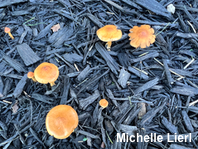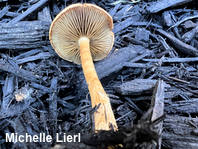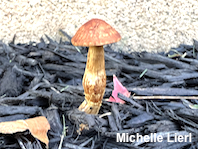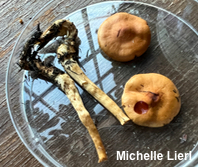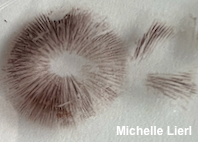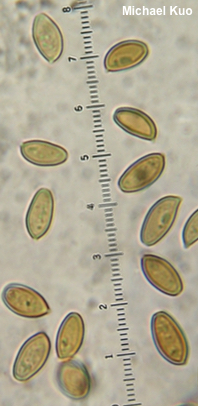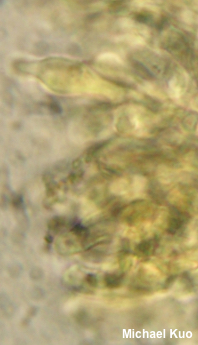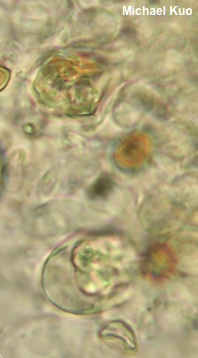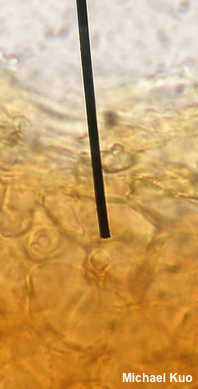| Major Groups > Gilled Mushrooms > Dark-Spored > Hypholoma > Hypholoma tuberosum |

|
[ Basidiomycota > Agaricales > Strophariaceae > Hypholoma . . . ] Hypholoma tuberosum by Michael Kuo, 4 April 2024 This rarely documented species of Hypholoma is a denizen of woodchip beds in disparate regions: Australia, temperate Europe, Japan, our Pacific Northwest, and a few states below the Great Lakes. It features a brownish orange cap, grayish brown gills, a purplish brown spore print, and a yellowish to orangish stem with a long, rooting portion (the stem's root terminates under the woodchips in a tuber-like knot of tissue called a sclerotium, which is not illustrated here). Under the microscope, Hypholoma tuberosum features ellipsoid spores with a small pore, lageniform cheilocystidia, and two features required for placement in Hypholoma: chrysocystidia and, below the pileipellis, a subpellis of inflated elements. Psilocybe tuberosa and Psilocybe tuberifera are synonyms. Thanks to Michelle Lierl for documenting, collecting, and preserving Hypholoma tuberosum for study; her collection is deposited in The Herbarium of Michael Kuo. Description: Ecology: Saprobic; growing alone, gregariously, or in loose troops on woodchips; summer and fall; originally described from British Columbia (Redhead & Kroeger 1987); recorded from Europe, Australia, Japan, and North America (the Pacific Northwest and the lower Great Lakes states); The illustrated and described collection is from Ohio. Cap: 2–4 cm across; broadly conic at first, becoming convex to broadly convex, often with a central bump; bald or slightly fibrillose; moist when fresh but soon dry; orange to brownish orange or reddish brown; the margin incurved when young, not becoming lined. Gills: Narrowly attached to the stem; close; short-gills frequent; pale grayish brown, with whitish edges. Stem: 2–4 cm long above ground; 4–8 mm thick; narrowing to apex; fibrillose; dry; pale yellow to orangish; with a fragile, fibrillose ring or ring zone that becomes blackish as spores mature; basal mycelium white; with a long "root" extending under the substrate. Flesh: Whitish; not changing when sliced. Odor and Taste: Odor reminiscent of green corn, or not distinctive; taste bitter. Chemical Reactions: KOH red on cap surface. Spore Print: Purple-brown. Microscopic Features: Spores: 9–11 x 4–6 µm; ellipsoid, with one end slightly truncated for a small pore; apiculate; smooth; thick-walled; yellow-brown in KOH; inamyloid (dull golden in Melzer's reagent). Basidia 18–22 x 4–6 µm; cylindric; mostly 4-sterigmate. Pleurocystidia as chrysocystidia; 25–40 x 7.5–15 µm; lageniform to subutriform or, after collapsing, saccate to irregularly cylindric; smooth; thin-walled; hyaline with golden globular contents in KOH. Cheilocystidia 20–28 x 4–6 µm; lageniform to subutriform or irregular; smooth; thin-walled; hyaline (but yellow en masse) in KOH. Pileipellis a thin ixocutis; elements 3–5 µm wide, smooth or encrusted, orange-brown in KOH, with clamp connections. Subpellis cellular; elements 10–30 µm wide, subglobose to ellipsoid, smooth, orange-brown in KOH. REFERENCES: S. A. Redhead & P. Kroeger, 1987. (Redhead & Kroeger, 1987; Noordeloos, 1999; Nagasawa et al., 2000; Antonín et al., 2009; Læssøe & Petersen, 2019.) Herb. Kuo 10062301. This website contains no information about the edibility or toxicity of mushrooms. |
© MushroomExpert.Com |
|
Cite this page as: Kuo, M. (2024, April). Hypholoma tuberosum. Retrieved from the MushroomExpert.Com Web site: http://www.mushroomexpert.com/hypholoma_tuberosum.html |
